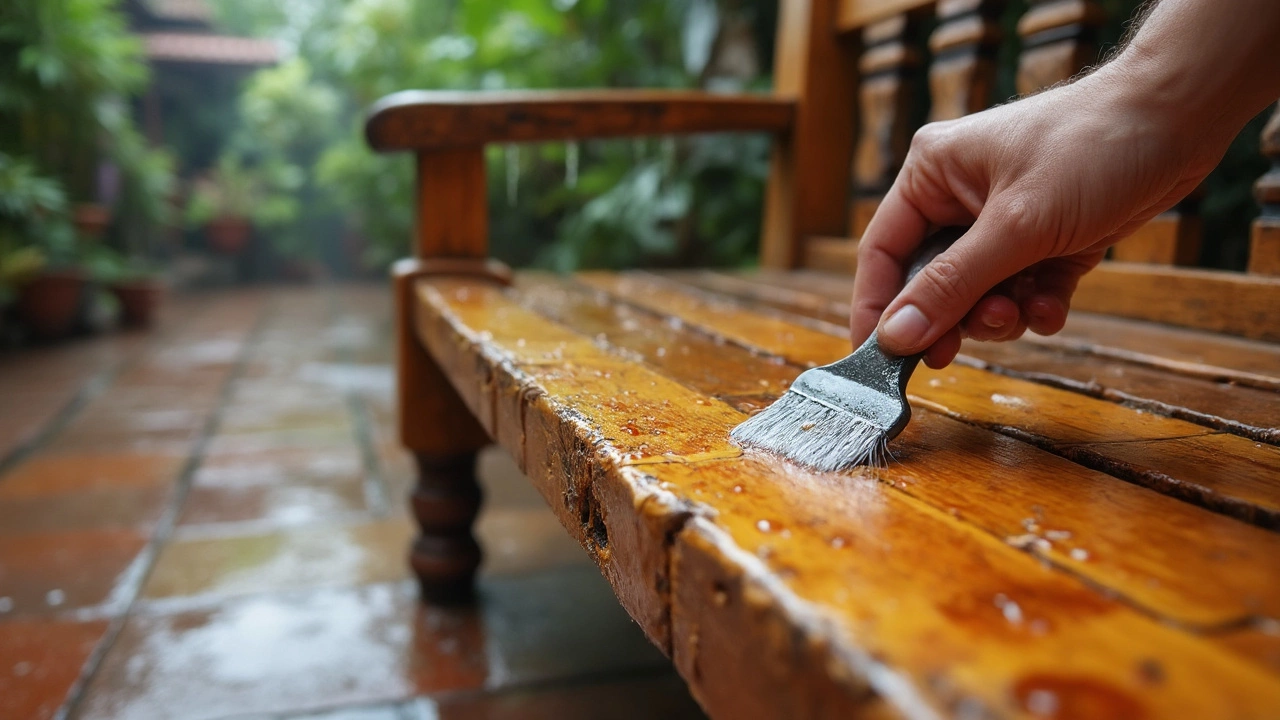Rot. It’s the silent enemy of garden furniture. You leave a wooden bench outside for a few seasons, and suddenly, the legs wobble and ugly patches appear. If you’re sick of tossing out moldy chairs or crumbling tables, you’re not alone.
Moisture is enemy number one here. The mix of rain, dew, and even just damp air seeps into untreated wood, breaking down fibers from the inside out. People sometimes think a basic paint job is enough—spoiler: it’s not. Even so-called "weather-resistant" furniture can fall victim if you skip the basics of routine care.
The good news? You don’t need fancy tools or a renovation budget to keep your outdoor gear solid. Sealing wood, lifting furniture off the ground, and giving it proper airflow make more difference than you’d believe. There’s a trick to almost every common problem—sometimes as easy as covering things up before a storm or using a homemade cleaning solution to block mold growth.
- Why Garden Furniture Rots
- Protective Finishes and Sealants
- Smart Placement and Storage
- Ongoing Maintenance Hacks
Why Garden Furniture Rots
Garden furniture looks solid, but if you leave it outside with no protection, nature goes to work fast. The real culprits are moisture, sunlight, and bugs. Wood, especially the softer types like pine, just isn’t built to handle endless cycles of wet and dry. It absorbs water like a sponge. Once soaked, the wood fibers start to weaken and fungi see that as an open invitation. That’s when you get soft spots and those gnarly, dark patches.
Sunlight isn’t exactly friendly either. It dries things out, sure, but it also breaks down the surface layer of wood or plastic. Ever see outdoor furniture go from rich brown to a dull gray or a faded color? That’s UV damage. It makes the material brittle, which helps cracks form. Once cracks show up, even more water finds its way in, making things worse in a hurry.
Here’s something a lot of people miss: metal parts and screws can rust. The rust eats away at hardware and leaves stains or even weakens the whole structure. As for bugs, termites and carpenter ants love untreated wood. If you spot tiny holes or sawdust-like piles around the legs, that’s a sign you’ve got company.
How fast does rot happen? Check this out:
| Wood Type | Avg. Time to First Signs of Rot (Unprotected) |
|---|---|
| Pine | 1-2 years |
| Teak | 6+ years |
| Acacia | 3-5 years |
| Plastic/Resin | Usually doesn’t rot, but fades/cracks after 2-3 years |
Most outdoor spaces throw a mix of these problems at your garden furniture every single season. If you want it to last, you’ve got to block out moisture and stay ahead of rot before it even gets a chance to start.
Protective Finishes and Sealants
Protective finishes are the real game changer when it comes to saving your garden furniture from rotting. The idea is simple: seal off any tiny cracks or gaps where water could sneak in. Not every sealant is made equal though, so knowing what actually works pays off.
Experts at Consumer Reports agree:
"Outdoor furniture lasts longer, and stays looking better, with a yearly coat of sealant. It’s the most effective step most people skip until damage is already done."
You’ve got choices, but here are the most practical options for outdoor furniture:
- Oil-Based Wood Sealers: Penetrate deep and flex with the wood. Great for teak, cedar, and pine.
- Exterior Polyurethane: Sits on top, forming a hard shield. It's ideal for flat surfaces like tabletops but can peel if applied too thick.
- Water-Repellent Preservatives: Perfect for heavy-use pieces; these contain mold-fighting additives.
- Paint with Primer: If you want color and protection, just make sure the paint is rated for outdoors and slap on an exterior primer first.
If you want the numbers, check this out. The table below sums up how long different finishes last with average use and a single proper application:
| Finish Type | Typical Protection | Ease of Reapplication |
|---|---|---|
| Oil-Based Sealer | 9-12 months | Easy (just wipe on again) |
| Polyurethane | 18-24 months | Moderate (must sand between coats) |
| Paint (with primer) | 24-36 months | Trickier (can chip and need scraping) |
| Water-Repellent Preservative | 6-9 months | Very easy (no sanding needed) |
Here are a few pro tips to make sealants work even better:
- Always clean and dry furniture before sealing. Dirt and moisture ruin even the best products.
- Sand lightly between applications. This helps new coats stick and prevents peeling.
- Don’t skip hidden areas like the feet of chairs and undersides of shelves. These spots rot first.
You only need about an hour to seal a bench or table. A quick yearly routine saves you way more money than replacing furniture every few years. Small steps, big payoff.

Smart Placement and Storage
If you want your garden furniture to last, where you put it is almost as important as what you put on it. Most people plop their chairs or table just anywhere, but not all spots are created equal. Direct contact with dirt or grass? That’s basically an open invitation for moisture, bugs, and fungus. Hard surfaces like patios, decks, or gravel beds keep wooden legs dry and keep insects away.
Shade can also be a double-edged sword. While a little shade protects from UV rays (which break down finishes), constant damp shade stops furniture from drying out after rain. The best spot has good air flow and several hours of sunlight daily but doesn’t roast in the midday sun.
- Never leave furniture touching bare soil or puddles. Elevate it or use rubber or plastic feet.
- Rotate your furniture every couple months so the same spots aren’t exposed to weather patterns all the time.
- Move furniture indoors or under a solid cover during harsh weather months—think a shed, garage, or weatherproof outdoor box.
- If you don’t have indoor storage, use breathable, waterproof covers. Avoid sealing furniture in plastic; it traps moisture and breeds rot.
If you’re curious about how much storage helps, check out these stats gathered from a 2023 outdoor living report:
| Storage Method | Average Furniture Lifespan (Years) |
|---|---|
| No storage, left outside year-round | 2-4 |
| Covered outdoors with waterproof cover | 4-7 |
| Moved indoors during harsh weather | 8-12 |
Bottom line: choosing the right spot, keeping things off damp ground, and not letting furniture sit out through every storm are habits that make a visible difference. These are quick fixes anyone can do, and the payoff is huge—you’ll actually get to enjoy your backyard setup instead of worrying about when it’ll fall apart next.
Ongoing Maintenance Hacks
If you want your garden furniture to last through more than a couple of summers, a little routine care goes a long way. The trick isn’t just doing things once when you buy it. You’ve got to stay on top of it—think regular, quick check-ins rather than hours of work.
Here’s what actually works:
- Seasonal checks: At least twice a year, give your furniture a close look. Flip chairs over and check the legs, especially where they touch the ground. Spotting early signs like soft spots, mold, or peeling finish saves headaches down the line.
- Clean off dirt and debris: Even a monthly hose-down helps. Leaves and junk can trap moisture against surfaces, basically helping rot do its thing. If you see green or black moldy bits, tackle them right away with a brush and a bit of soapy water. For tough spots, white vinegar mixed with water works wonders.
- Tighten and fix: Don’t ignore wobbly screws or missing bolts. When structure loosens, water sneaks in and rotting speeds up. A basic screwdriver and some patience take care of most issues.
- Re-seal wood: Outdoor wood finishes can wear off in a season. If water stops beading up on the surface, it’s time for a fresh coat of sealant or oil. Most people do this once a year—it’s simple, just follow the instructions on the product.
- Store or cover in rough weather: Even plastic covers aren’t just for winter. Thunderstorm in the forecast? Toss on a cover, even for a day. Better yet, stash lighter stuff in a shed or under a covered porch whenever weather gets nasty.
Each of these steps only takes a little time but makes a major difference in how long your furniture holds up. Stick to these hacks, and you’ll spend more time relaxing and less time shopping for replacements.

